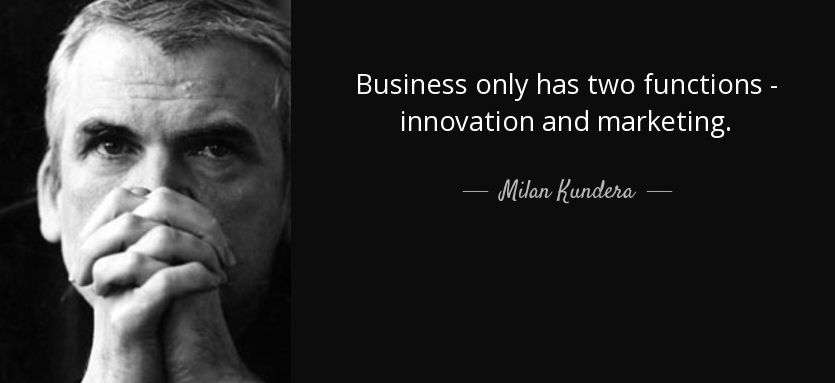Business presentations have come a long way from the dry recitation of quarterly results, the predictable analysis of strengths, weaknesses and opportunities, and the proposed strategic plan ‘going forward’.
These days it’s pretty much de rigeur to liven up your presentation with a slide containing an inspirational quotation from Gandhi, Churchill, Einstein, or some other admirable historical figure. The further they are removed from the world of business the better – it makes them sound more authentic.
But in the absence of one of these global gurus, many coaches and public speakers are happy to plump for any canny definition from a contemporary business leader or (preferably) ‘influencer’. Take this for example: “Business has two — and only two — basic functions: marketing and innovation.”
Set against a landscape of rolling hills, this snappy blue-sky quotation is the perfect opener, instantly clearing away the clutter and causing us to look at the world of business afresh, through the eyes of …. who? Now who did say that? Seth Godin? Bill Gates? Donald Trump? Alan Sugar?
Try again. According to the internet, these are the sententious words of none other than Milan Kundera, the Czech-born, Paris-dwelling author of the darkly ironic The Unbearable Lightness of Being, The Book of Laughter and Forgetting, and The Joke.
Now to anyone who has read him, the attribution to Kundera really seems somewhat unlikely. After all, this author, whose works combine political satire and philosophical musings on humanity and fate, is not known for his pronouncements on the business world. Yet here they are, slide after slide (I have shown only two on this page), showing the brooding Kundera now re-cast as business guru, the rebellious author as social media influencer.
So widespread is the error that even the hallowed Economist has included the ‘Milan Kundera’ line in its 2012 Book of Business Quotations. In fact, it may well be its inclusion in that weighty tome that has convinced many internet users that the quotation must be authentic.

But if not Kundera, who exactly did come out with this (after all fairly platitudinous) bit of business-speak? Well, it will hardly surprise many readers from the world of corporate management to learn that the actual author was Peter Drucker, the highly prolific ‘father of management thinking’. In Drucker’s 1954 book The Practice of Management, we find the following: “Any business enterprise has two — and only two — basic functions: marketing and innovation.” Bingo.
Yet a number of websites — including one called Marketing Insider Group — still defend the attribution to Kundera, with sentences like these:
(Knowledge drop: Most people attribute the above quote to Peter Drucker who clearly borrowed from the author of The Unbearable Lightness of Being when he said: “Because it is its purpose to create a customer, any business enterprise has two – and only these two – basic functions: marketing and innovation.” But Milan said it first.)
What? When he was only 15 years old?
Now my real problem with all this is that if the opening slide of the presentation gets the quote wrong, or happily goes ahead and attributes it to the wrong person (and the example of Milan Kundera is — believe me — just the tip of the iceberg), then why on earth should we trust the slides that come next?
Why might the graphs showing growth over the last quarter not also be riddled with mistakes, accidental or otherwise? Why might the strategic plan not be copied from another company’s website? (after all, plagiarism is not unknown, even in the world of business). And why might not some of those great corporate strengths actually be weaknesses?
I imagine some readers find my objection to those using ‘fake news’ somewhat flippant. Just ask then, was the chart showing diesel emissions to Volkswagen shareholders accurate? Do documents listing workplace policies on pay and conditions always resemble the truth? Or are they, too, examples of ‘sliding truths’?
So much of what we see at first sight in a presentation is superficial, and sadly is too easily accepted by the audience. It is our job to question it. That’s hard, but it has to be done. Or, as Milan Kundera actually noted: ‘On the surface, an intelligible lie; underneath, the unintelligible truth.’

